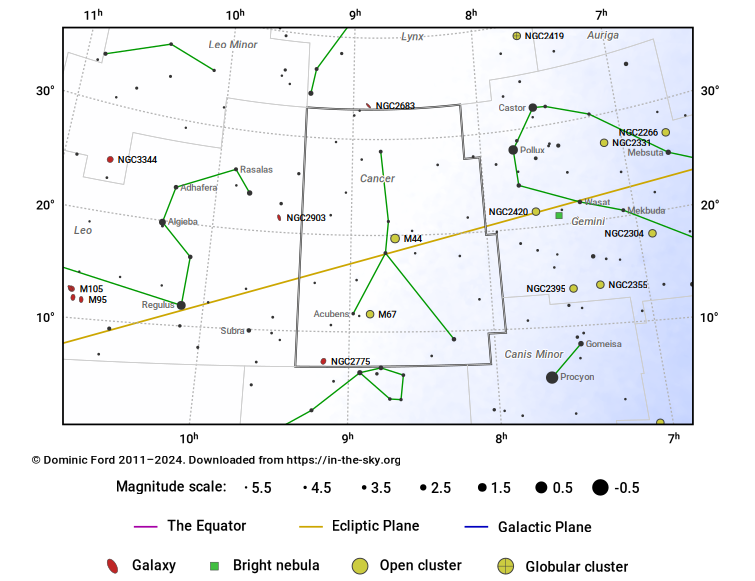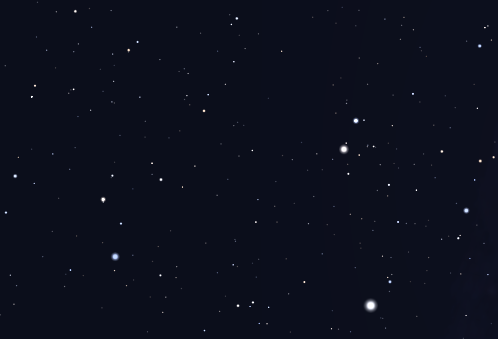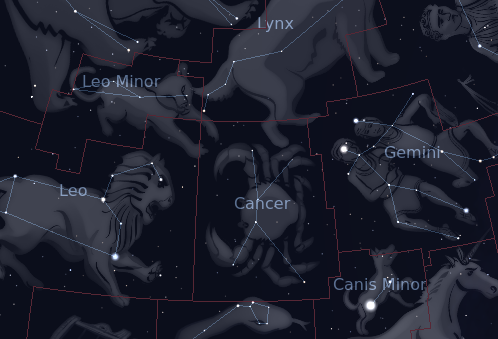The Constellation Cancer
Cancer is a moderately sized constellation visible in the northern sky around February, and one of the twelve members of the zodiac.
Despite this, it is not particularly conspicuous. Its brightest star has a magnitude of only 3.5.
It is best known for its deep sky objects, and in particular the open cluster M44, the Beehive cluster or Praesepe. This can be found near the center of the constellation.
Cancer is Latin for ‘crab’ and is identified with a rather inconsequential event in Greek mythology. The crab in question appeared while Hercules was fighting the Hydra, and bit his foot. Hercules then crushed it, and that was the end of the crab.
The constellation gives its name to the Tropic of Cancer, the line at a latitude of 23.5°N where the Sun is overhead at the June solstice. In ancient times the Sun lay in the constellation at the time of the solstice, though this is no longer the case. The precession of the equinoxes means the Sun now lies in Taurus on June 21.
Ancient
1.2% of the sky
505.9 square degrees
Hover the pointer over the name of an object to highlight its position on the starchart to the right, or click to see more information.
| Stars | Open Clusters | Globular Clusters | Galaxies |
| β-Cnc (mag 3.5) | Messier 44 (mag 3.1) | NGC 2775 (mag 10.3) | |
| Asellus Australis (mag 3.9) | Messier 67 (mag 6.9) | NGC 2513 (mag 11.6) | |
| ι-Cnc (mag 4.0) | NGC 2664 | NGC 2672 (mag 11.6) | |
| Acubens (mag 4.3) | NGC 2678 | NGC 2749 (mag 11.8) | |
| Asellus Borealis (mag 4.7) | NGC 2554 (mag 12.0) | ||
| HIP 41325 (mag 5.1) | NGC 2608 (mag 12.2) | ||
| χ-Cnc (mag 5.1) | NGC 2563 (mag 12.3) | ||
| 8-Cnc (mag 5.1) | NGC 2595 (mag 12.4) | ||
| ξ-Cnc (mag 5.2) | NGC 2577 (mag 12.4) | ||
| κ-Cnc (mag 5.2) | NGC 2545 (mag 12.4) | ||
| O¹-Cnc (mag 5.2) | NGC 2750 (mag 12.6) | ||
| σ³-Cnc (mag 5.2) | NGC 2535 (mag 12.7) | ||
| ρ²-Cnc (mag 5.2) | NGC 2648 (mag 12.7) | ||
| ζ²-Cnc (mag 5.3) | NGC 2619 (mag 12.7) | ||
| μ-Cnc (mag 5.3) | NGC 2673 (mag 12.9) | ||
| η-Cnc (mag 5.3) | NGC 2764 (mag 12.9) | ||
| θ-Cnc (mag 5.4) | NGC 2804 (mag 12.9) | ||
| π-Cnc (mag 5.4) | NGC 2562 (mag 13.0) | ||
| τ-Cnc (mag 5.4) | NGC 2575 (mag 13.0) | ||
| σ²-Cnc (mag 5.4) | NGC 2558 (mag 13.0) | ||
| ν-Cnc (mag 5.4) | NGC 2809 (mag 13.0) | ||
| 60-Cnc (mag 5.5) | NGC 2789 (mag 13.1) | ||
| φ¹-Cnc (mag 5.6) | NGC 2582 (mag 13.1) | ||
| BP Cnc (mag 5.6) | NGC 2794 (mag 13.2) | ||
| 3-Cnc (mag 5.6) | IC 509 (mag 13.2) | ||
| BM Cnc (mag 5.6) | IC 2378 (mag 13.2) | ||
| BI Cnc (mag 5.6) | NGC 2560 (mag 13.3) | ||
| Tegmine (mag 5.6) | IC 2421 (mag 13.3) | ||
| A¹-Cnc (mag 5.6) | NGC 2599 (mag 13.4) | ||
| σ¹-Cnc (mag 5.7) | NGC 2744 (mag 13.4) |




